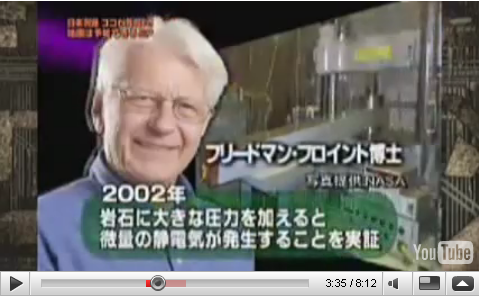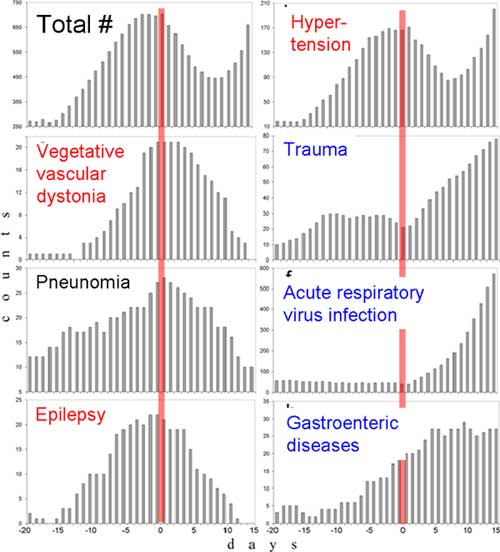科学的コミュニティー、意志決定者及び公衆への公開状
地震前兆信号の理解に
我々は如何に程遠いか?
フリードマン T. フロインド
SETI研究所 カールセーガンセンター 主任研究員
NASA Ames Research Center, MS 242-4
MOFFETT FIELD, CA 94035-1000
Tel (at NASA) 650 604-5183
Tel (at CSC) 650 810-0218
Cell 650 279-8478
e-mail ffreund@mail.arc.nasa.gov
サンノゼ州立大学
物理学科
地震は莫大な破壊をもたらします。地震は何万人もの人々の死や何十億ドルもの経済損失を引き起こします(トルコでも発生しました)。
次の大地震は確実に来ます。それはトルコの歴史で最も悲惨なものかもしれません。地震は突然発生するように見えるので恐れられます。そのような事象は本質的に予測不可能であると多くの地震学者は言います。
これについて的確に見通すために、私たちは地震学者が地震を地球の内部を照らすための“フラッシュライト”として利用することを覚えておく必要があります。地震波を分析し、それがどのように伝播するかを理解することによって、地震学者は私たちのダイナミックな惑星の隠された構造を発見する精巧な道具を開発しました。地震学者は私たちの感謝に値する驚くべき仕事を成し遂げました。
しかしながら、地震予知のことになると地震学者によって開発された道具は役に立ちません。地震のリスクに対する地震学のアプローチは、過去の調査であるためはっきりしません。「過去の地震を調べて、例えば次の7年もしくは30年間先の発生確率を計算します」という風に。
この過去をふりかえるアプローチは甚だ不十分です。地震が予測できないと言う人々は、不都合な真実に真正面から取り組みません:地震予知は過去の大地震の歴史によるだけではなく、リアルタイムで地殻深く展開するプロセスによるのです。
地球が大きな地震の前にシグナルを発することは、何十年も何世紀も前から知られています。めまぐるしく多様で、時には異なり、しばしば微妙で統一のないシグナルを:
(i) 地上100~300km上空の電離層擾乱
(ii) 地表面から約1000mまでの高さの大気中の変化
(iii) 夜間衛星画像で見える震央域からの赤外線放射増加
(iv) 世界中で記録された超低周波の電磁放射
(v) ローカルな磁場変化
(vi) 奇妙な動物行動
(vii) その他…
最近まで科学的コミュニティーは、様々な種類の信号がどのように発生するのか大雑把にさえ説明することができませんでした。これらの信号の物理的な基礎を提供し、それらがどのように関係しているのか、誰も説明できませんでした。
上記のものが地震前兆信号の全てではありませんが、ここ2年間に、その多くの発生原因と思われる地球の内部プロセスに関する私たちの洞察に大きな進展がありました。
鍵は火成岩が圧力にかけられるとき、休止状態の電荷キャリアが活性化するという発見です。 この起動プロセスの結果として、圧力を加えられた岩石がバッテリーとなって電流が流れ出すということです(Freund and Sornette, 2007; Freund et al., 2006)。
これらの電流はかなり強い場合があります。 実験室データによると、圧力を加えられたあらゆる立方キロメートルの岩石は、長時間にわたって1万から10万アンペアに達する電流を流すことができます。更に驚くべきことに、これらの電流は厚い層の岩石を通して流れることができます。この電荷キャリアは、緩く固く締まった砂や土を通り抜けることができます。水によって止められません。おそらく1kmから10km単位の距離を流れます。
この電荷キャリアは実験室の岩石表面に、そしておそらく地球表面にも正の帯電を発生させます。この帯電は電離層に影響を与えるとともに、広く報告された地震前電離層擾乱につながるほど強いかもしれません(Liu et al., 2006)。
この電荷キャリアは、微小な領域ですが大変に強い電場を表面に発生させます。それは空気をイオン化させるのに十分な強度です(Freund, 2003)。大気中の水蒸気圧が適正な範囲であれば、大気イオンは水滴の凝縮を引き起こし、雲を形成します。表面へ流れる電荷キャリアの数が増加すれば、可視光と広帯域の電波雑音の放出につながるスパークとコロナ放電が発生します(Freund, 2002)。
表面でこの電荷キャリアが再結合すると、熱振動する励起状態の“熱い”原子を形成します。それらは、中間赤外光子のスペクトルを放射することにより脱励起します(Freund et al., 2007)。この新たに発見された放射プロセスは、衛星の赤外線画像で夜間に観測される不思議な地震前兆“熱異常”の原因かもしれません。
主流の科学は科学の最前線の急速な展開にまだ追いついていませんが、私たちは地震前兆信号の謎を解き明かしつつあります。どのように発生するのか、これらの信号が何であるか、それが地球の奥深くに潜む危険について私たちに告げることができることを理解しはじめます。確かなことは、地震前のシグナルはおかしな疑似科学者の発明品でも、年老いた村人のほら話でもありません。これは現実の物理的現象なのです。
昔から地震学のコミュニティーの多くが言い続ける「地震前シグナルは信頼に値しない、もしくは存在さえしない」という諺は、道徳的・科学的に無責任です。
Freund, F.T. 2002. Charge generation and propagation in rocks. Journal of Geodynamics, 33: 545-572.
Freund, F.T., 2003. Rocks that crackle and sparkle and glow - Strange pre-earthquake phenomena. Journal of Scientific Exploration, 17: 37-71.
Freund, F.T. and Sornette, D., 2007. Electromagnetic earthquake bursts and critical rupture of peroxy bond networks in rocks. Tectonophysics, 431: 33-47.
Freund, F.T., Takeuchi, A. and Lau, B.W., 2006. Electric currents streaming out of stressed igneous rocks - A step towards understanding pre-earthquake low frequency EM emissions. Physics and Chemistry of the Earth, 31: 389-396.
Freund, F.T. et al., 2007. Stimulated thermal IR emission from rocks: Assessing a stress indicator. eEarth, 2: 1-10.
Liu, J.Y. et al., 2006. Seismo-geomagnetic anomalies and M5.0 earthquakes observed in Taiwan during 1988-2001. Physics and Chemistry of the Earth, 31: 215-222.
Acknowledgement: I wish to express my gratitude to Dr. Friedemann T. Freund and Dr. Ronald Karel who permits reprinting, and Dr. Akihiro Takeuchi who checked the translation.
And more
現実に乗り越えなければならない唯一の障壁は、自分たちがそれまでに学んだり理解してきたことを根本から覆すような新たな発見を受け入れようとしない多くの地震学者たち(あるいは科学者一般)の頭の中にある旧来からの観念です。我々の科学的活動およびその資金調達は、承認(制度)に基づいているため、意欲的なアイデアを遂行しようとそれを匿名でなされる審査に提出したところで、それが認められるかどうかは、まさにギャンブルと同様、確実なことは誰にもわかりません。あらゆる可能性に対する頑固な粘り強さだけが、科学界の保守的傾向といわれる障壁を乗り越えることができるのです。
地震調査の画期的研究 - KaleidaGraphがSETIの研究者を支援(HULINKS)
→Science Moving Ever Closer to Identifying Earth's Core Connection to Earthquakes and Volcanoes (Earth Changes Media, Dec 29, 2006)
Pre-earthquake signals – Part I: Deviatoric stresses turn rocks into a source of electric currents
Pre-earthquake signals – Part II: Flow of battery currents in the crust
After Quake, Attention Grows On Early-Warning Systems
That doesn't discourage Dr. Freund, who is 75 years old. He has invested $1 million of savings held by him and his wife, the novelist Hisako Matsubara, in his research, he said. Their son, Minoru Freund, is the director of the Center for Advanced Aerospace Materials and Devices at the NASA Ames Center in nearby Mountain View, Calif., and has worked with his father on his theories. The pair hope that satellites could help them take their theories to the next step.Source: After Quake, Attention Grows On Early-Warning Systems (Wall Street Journal, 2008.5.20)
Dimitar Ouzounov, the NASA scientist who sent the Sichuan email, was studying thermal patterns as part of his work on atmospheric changes ahead of earthquakes. His research competes with that of Dr. Freund but is predicated on the same concept: that it could be possible to warn that quakes are coming.
Plan for quake 'warning system'
The team at Nasa has also been working with Surrey Satellite Technology Limited (SSTL) in the UK, to investigate the feasibility of a satellite-based early warning system. Stuart Eves, head of business development at the company, told BBC News: "The evidence suggests we're now crossing the boundary in terms of technology readiness."Source: Plan for quake 'warning system' (BBC, 2008.6.5)

Recently, though, the USGS appears to have had a change of heart: it has invited Freund to give a talk next month. However, for the man who has made such a huge personal and financial commitment to his work, entering what he calls “the lion’s den” is not a matter of pride but the sole opportunity to mend the perceived fault line separating his work from established science, and perhaps give stability to the many millions of people living on uncertain ground.
Towards a Unified Theory for Pre-Earthquake SignalsSeminar hosted by the Earthquake Hazards Team, U. S. Geological Survey, Feb. 04, 2009 |
| 2009 International Workshop on Validation of Earthquake Precursors by Satellite, Terrestrial and other Observations (VESTO) |
Russian scientist Dimitar Ouzounov says stresses on the Earth's crust leading up to a quake cause gases like radon to escape into the atmosphere -- 100 miles above the Earth they ionize and create heat that is detectable by satellites. Ouzounov's team says out of 24 quakes in Japan of magnitude 7 or greater, all showed the same atmospheric signals beforehand.
The NASA Russian team's data on the 24 Japan quakes will be released late this year.
Any good seismologist will recognize the limitations of earthquake prediction. But the study of earthquakes should include the tracking down and investigation of all the different signals that Earth produces before a catastrophic rupture. If seismologists can't do it alone, can't we do it collectively across disciplines?
Emergency visits prior to the Magnitude 7.5 Chuya earthquake in Siberia. September 27, 2003. A. Shitov, 2010
Key to Understanding Pre-Earthquake Phenomena
The team's findings are published in the International Journal of Environmental Research and Public Health. In this paper, they describe a mechanism whereby stressed rocks in the Earth's crust release charged particles that react with the groundwater.
Animals that live in or near groundwater are highly sensitive to any changes in its chemistry, so they might sense this days before the rocks finally "slip" and cause a quake.
The team, led by Friedemann Freund from Nasa and Rachel Grant from the UK's Open University hope their hypothesis will inspire biologists and geologists to work together, to find out exactly how animals might help us recognise some of the elusive signs of an imminent earthquake.
|
|
Dedicated to the memory of Minoru M. Freund
2013 NASA Ames Virtual Poster Fair - List by Organization: Code S
Robert Thériault, France St‐Laurent, Friedemann T. Freund and John S. Derr* Earthquake lights linked to rift zones (Nature) | 地震前の謎の発光現象、ついに解明か? (National Geographic News) | Moses' burning bush explained? The mysterious physics behind earthquake lights (Friedemann T. Freund, The Conversation)
Electronic supplement to Prevalence of earthquake lights associated with rift environments
But as well as monitoring migrations, ICARUS will also be used to look for unusual movements of animals. Martin Wikelski, a professor of ornithology involved with the project, explains that ICARUS will test for the first time whether flying animals can be used as "intelligent sensors" of impending earthquakes.
Birds and bats might serve the purpose because of their ability to detect magnetic fields. This capability probably helps the creatures navigate –but it could also allow them to sense earthquakes before they strike.
Since the late 1990s, it has been known that fluctuations in the Earth's magnetic field occur before some earthquakes. The reason why, however, had eluded seismologists until the early 2000s, when a bizarre new property of rocks was discovered.
The underlying cause of all earthquakes is the build-up of stress in subsurface rocks—invisible at the Earth's surface. But laboratory tests carried out in 2002, by NASA’s Friedemann Freund, revealed that the stresses which lead to earthquakes can be detected electromagnetically.
Friedemann Freund briefed NASA Ames Center Director Pete Worden April 11 on the Global Earthquake Forecasting System, together with Patrick Hogan, WorldWind Program Manager, and Kevin Montgomery, CEO of Intelesense, Inc. The Global Earthquake Forecasting System will consist of two major components: a ground station component and a satellite component. For the ground station component, we already have teams set up for forming in over ten seismically active regions (Alaska, Quebec, Haiti, Jamaica, Puerto Rico, Colombia, Peru, Italy, Spain, Greece, Romania, Turkey and India). For the space component NASA Ames is already talking to and collaborating with LuxSpace in Luxembourg. (4/18/14)
GeoCosmo Earthquake Forecast System
Invited Session "Data Visualization and Analytics"
Chairs: P. Hogan, M. Brovelli
Keynote Talk 2: Global Earthquake Forecasting System
K. Montgomery, F. Freund, P. Hogan (Intelesense, NASA)
Day 1 Keynote Speaker: Dr. Friedemann Freund
SEISMOLOGISTS tend to greet the idea that some animals know when an earthquake is coming with a sizeable degree of scepticism. Though reports of odd animal behaviour before a quake date back at least as far as ancient Greece, the data are all anecdotal. They are also subject to vagaries of the human psyche: “confirmation bias” ensures that strange behaviour not followed by earthquakes gets forgotten, and “flashbulb memory” can, should an earthquake strike, imbue quotidian animal antics with great import after the fact. The US Geological Survey―arguably the world’s authority on earthquakes―undertook studies in the 1970s to find out if animals really did predict them, but came up empty-handed. However, the latest data, just published in Physics and Chemistry of the Earth, are not just anecdotal.
Ron Fortunato, Levi Purdy
GEOCOSMO* Geocosmo can forecast earthquakes weeks in advance - winner of Singularity University Grand challenge with Disaster Resilience (Next Big Future)
Who we are: GeoCosmo's team has predicted 20 of 20 earthquakes up to seven days in advance to the hour (19 of 20) and one four hours in advance since 2015.
Earthquakes kill the unsuspecting. Earthquakes destroy property. There are over 2 billion people living in highly seismic regions. Every major earthquake is preceded by measurable pre-earthquake (pre-EQ) signals, typically days, sometimes weeks before the main shocks. GeoCosmo and its network of NASA and academic researchers around the globe have measured these bursts of airborne ions and have successfully forecast 20 of 20 earthquakes over the past eighteen months.
Our Mission: Saving 10,000's of lives each yearPeruano #JorgeHeraud como speaker en el #GSummit @singularityu @pucp Director del #INRAS #Peru #Ciencia #GeoCosmo pic.twitter.com/7ARCpgZB5G
— Jaime Sotomayor (@jaimersb) 2016年8月29日
NEW YORK, Sept. 13, 2016 /PRNewswire/ -- Arria NLG (AIM: NLG), a world leader in artificial intelligence ("AI") and natural language generation ("NLG"), and GeoCosmo Sciences SPC ("GeoCosmo"), a global project based out of NASA's Ames Research Park in California, is pleased to announce a partnership to build precision NLG capabilities into the GeoCosmo Earthquake Forecasting Service™ to improve communication and advance notification of the deadliest natural disasters.
Proud to support #TEDxChCh w/ former @NASA senior scientist Dr Friedman,an expert in #earthquake detection #GeoCosmo https://t.co/n9rQ6L9spg
— US Embassy NZ (@usembassynz) 2016年9月13日
First Place Winners!!! Earthquake Signal Precursors (ESP) Trillium Learning & Kodiak Island Borough District
Students acquire precursor earthquake data from sensor arrays and develop real-time data visualization models utilizing NASA WebWorldWind. The data server resides within A World Bridge Project server in Kodiak, Alaska. This team is developing ground station technology platforms, which acquire continuous magnetic field information at 50Hz from remote locations.
Data acquisition stations continuously transmit data to servers designed to record, visualize, and archive this data. Data visualization events represent 3-axis precursor magnetic anomalies as dynamic vectors, providing advanced warning via anomaly detection algorithms for specific areas of increasing tectonic plate stress. Visualizations are then accessible through the ESP NASA World Wind application.
* Kodiak High School Team Wins Europa Challenge Second Year in a Row
A World Bridge: Earthquake Signal Precursors | ESP! Earthquake Signal Precursors
* Earthquake Signal Precursors project, ESP, is working to develop an accurate forecast system for an impending earthquake
By Vanessa Bates Ramirez
Can animals help us predict earthquakes? A new study involving Hartpury lecturer, Dr Rachel Grant, will aim to unearth the link between animal behaviour and seismic activity.
* experiment: Can frog and bird calls warn us of impending earthquakes?
Listen to the full interview with Dr Friedemann Freund
"When nature stresses certain rocks, electric charges are activated, as if you switched on a battery in the Earth's crust," senior researcher at NASA's Ames Research Center, Friedemann Freund, told National Geographic in a 2014 article about the phenomenon.
Mr Freund said the right conditions for earthquake lights occur in less than 0.5 percent of earthquakes worldwide.
El Dr. Friedemann Freund de la NASA @pucp #AulaMagna2016 pic.twitter.com/iqYeAf4kVV
— Luis Torres Valerin (@ltorresvale) 2016年11月16日
SETI Institute scientists will include Jill Tarter, Mark Showalter, Jon Jenkins, Oana Marcu, Friedemann Freund. Bill Diamond, the CEO of SETI Institute will also be joining.
Key Speakers Friedemann Freund (USA)
